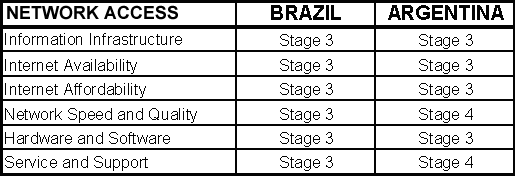Network Access
Ebony
L. Milton | David Wendland | Daniel
Cureton | Calvin Wright

Access to information and the speed to which that information can be
accessed have become critical factors not only for business, but for personal
reasons as well. In today's Internet and communication centric world Network
Access has become an intricate part of everyday life. When investigating
the readiness of a developing country for entering the networked world,
19 categories are evaluated. These 19 categories are grouped together
in to five major topics: Network Access, Networked Learning, Networked
Society, Networked Economy and Networked Policy. Our team was selected
to evaluate the portion of Argentina's and Brazil's Network Readiness
with regard to Network Access. The topic Network Access groups the following
six categories:
| Information
Infrastructure. For most communities in the developing world,
a lack of access to voice and data services remains a significant
impediment to Networked Readiness. Communications infrastructure is
deployed with widely varying local and regional rates of penetration,
depending on factors such as geography and/or income levels. Local
network access may be provided by any one of a number of media that
make up the communications network (including twisted pair copper
wire, coaxial cable, wireless local loop, satellite, fiber optics
and mobile wireless).
Internet Availability. Internet access is enhanced by competition
among Internet Service Providers (ISPs) that operate locally. The
range of services offered, number of dial-up lines (which helps
determine ISP capacity) and transmission capacity all influence
an ISP's usefulness. The availability of leased lines is particularly
important in making the Internet available to the business community.
Finally, in many communities in the developing world, public access
is essential to making the Internet available to greater numbers
of individuals and firms. Telecenters, Internet cafes and community
information centers assume great importance in making the Internet
available to those who do not have personal access at home, school,
work or elsewhere.
Service and Support. A strong customer service orientation
is important in determining the success of network deployment. Long
waiting periods for installation and repair and a lack of support
services by telephone companies and Internet providers pose major
obstacles to Readiness. The quality and number of technical support
professionals are essential in maintaining the network and providing
service.
|
Network Speed and Quality. The available bandwidth, both
for individuals & local access and for a community's connection
to the Internet backbone, determines the number of users and types
of online activities the network can support. Bandwidth-intensive
activities, such as large file transfers or video streaming, may
be unavailable to communities with constrained access to the network.
The quality of the network, including servers, also determines its
usage. High numbers of mainline faults, poor connections, dropped
connections and packet loss can render any network useless or operationally
sub-optimal, thus discouraging use of and investment in new technologies.
Hardware and Software. A vibrant market with numerous hardware
and software options can encourage more specialized usage of the
network, including ICT solutions that are tailored to local needs.
More widespread retail and wholesale distribution channels for both
hardware and software increase opportunities to use the network
within the community. The prices of hardware and software are particularly
important in the developing country context, where generally low-income
levels cannot support high-priced consumer items.
Internet Affordability. The prices which businesses and
individual consumers pay for Internet access are in most cases determined
by a combination of fees for basic telephony and ISP services. In
communities where the sum of ISP and telephony fees is prohibitively
high, a disincentive to network usage exists, and access is curtailed.
Pricing packages can be structured in ways that are conducive to
Internet usage per minute or hourly pricing (unlike flat rate pricing)
for both Internet and telephone service can limit users' time online
and therefore inhibit the use of the network for many activities
such as e-commerce. The provision of tiered pricing packages can
improve the affordability for many subscribers by allowing them
to purchase only what they need.
|
The six categories of Network Access are further divided in to four distinct
stages of development (stage 1- stage 4). Each stage has specific measurable
requirements associated with it. Stage 1 indicates that the country as
made very little or no progress as it relates to the that category where
stage 4 is drastically different and much closer to what you would expect
to see in developed countries like US, Western Europe and Japan.
A rating of stage 1 for overall Network Access is as follows:
- Little or no telecommunication infrastructure.
- The availability of the information and communication technology (ICT)
services is almost non existent.
- The lack of availability results in the costs being too high so personal
and small/medium businesses cannot use them.
- From a speed and quality standpoint, most phone calls are unsuccessful,
limited services beyond basic e-mail.
- No distribution/sales points of ICT hardware and software within the
community and even most businesses cannot afford to use them.
- Service and support of the phone mainlines take at least 4 years to
be installed, six months for reported failure correction and virtually
no software developers or technicians in the community.
A rating of stage 4 for overall Network Access is as follows:
- Strong and widespread access to telecommunications and network services,
high teledensity level, strong wireless community
- More than two local ISPs per 1MM people, high bandwidth solutions,
reliable dialup, availability of leased lines to businesses
- Competitive and affordable rates to phone and internet/network services,
free ISPs available
- Almost no dropped calls, few faults per year reported, strong backbone
to support high speed services with low packet loss of network data
- Software and hardware market is fully developed with local needs and
languages met. Retail availability of hardware and software solutions
is strong
- Main phone line installs are usually completed in days from time of
order, multiple methods for customer service communication (e-mail,
call, etc), maintenance and service of ICT systems are widely available.
In short, when evaluating a country's Network Access we are looking at
the availability, cost, quality, the services, support, and maintenance.
Network Readiness requires access to an adequate network infrastructure,
without it a developing country is virtually disconnected and cannot communicate
with the rest of the networked world. Following the existence of a strong
infrastructure the availability, affordability, speed, available hardware
and software and service/support all play major roles in the determination
of how the network is used and applied. Shortcomings in either network
speed or network quality will have significant repercussions on the ability
of customers to access information through the network, thereby discouraging
use and adoption new technologies.
Argentina and Brazil are well on their way to competing in the global
IT market place. The overall rating of Argentina is between 3 and 4. While
the country's Network Assess is strong from the perspective of Internet
availability, Infrastructure, Speed and Quality the main limiting factor
for Argentina is their current economic situation that puts the networked
products out of reach of many individuals. Brazil's overall rating is
just slightly lower coming in at a solid 3. Brazil needs to focus on service
and support as well as hardware and software availability issues. The
infrastructure is continually strengthening and the government is starting
to put measures in place to promote network access to all. The following
table list by Network Access category what stage the country would fall.

|
|












![]() Group Projects
Group Projects